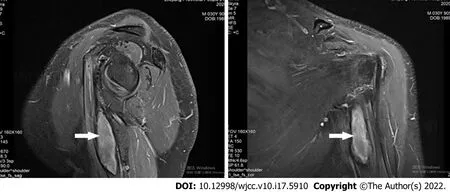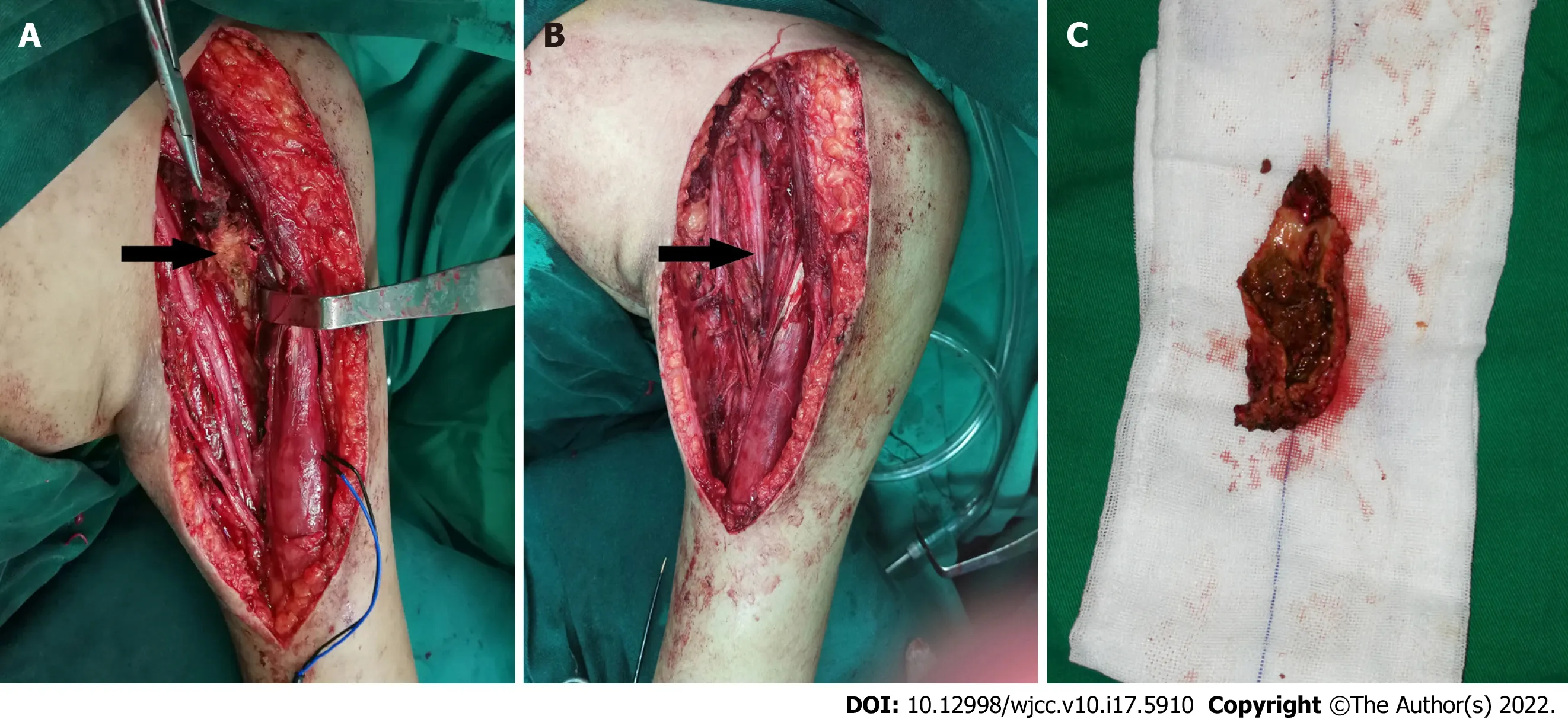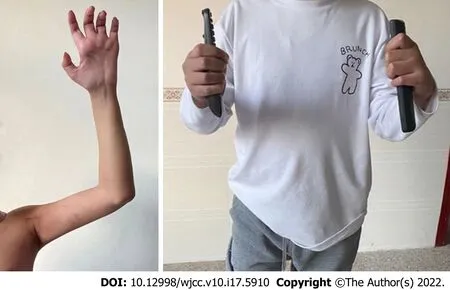Tumor-like disorder of the brachial plexus region in a patient with hemophilia:A case report
lNTRODUCTlON
Various tumors and tumor-like disorders,originating from the neural sheath,as well as other types,may affect the brachial plexus region[1,2].In cases of brachial plexus lesions,no imaging or radiographic test that is currently available,such as angiography,computed tomography(CT),or magnetic resonance imaging(MRI),is able to reliably distinguish between benign and malignant neurogenic tumors[3].Use of nonspecific symptoms and imaging findings for preoperative diagnosis probably leads to error.
The case reported here was a 30-year-old man with hemophilia,as well as both sensory and motor dysfunction of the left upper extremity.A presumptive diagnosis of brachial plexus tumor was initially made,which was subsequently confirmed to be an organized chronic hematoma rather than a neoplasm.Due to the infrequent presentation,brachial plexus palsy caused by spontaneous hematoma in patients with hemophilia might miss the treatment by early surgical decompression and progress to permanent nerve damage.We presented our experience with successful surgical management of a brachial plexus tumor-like disorder,which was eventually proved to be an extrinsic muscular hematoma in the vicinity of the plexus.
CASE PRESENTATlON
Chief complaints
A 30-year-old man with hemophilia A had numbness and paresthesia on the entire left forearm and hand.He complained of swelling and pain in his left arm and denied a history of trauma.He described nearly complete loss of flexion of his left elbow,wrist and finger joints afterwards.
The Afrikakorps commander, Gen. Erwin Rommel, shrewdly saw the song as a means to rally his men. He ordered “Lili” played every night. At 9:55 each evening the song became Radio Belgrade s sign-off and cast its magic spell almost until the war s end.
History of present illness
He missed early operation,due to the high risk of hemorrhage,probably aggravated by surgical intervention.The symptoms worsened throughout the subsequent 2 mo.He was referred to our hospital 2 mo after the onset of symptoms.
High quality CT or MRI was conducted to delineate tumor location,margins,and relationship to surrounding structures.MRI may also determine whether the contents are in liquid or in solid form[1,3].Nevertheless,an organized hematoma has no particular differentiating imaging features.The interest in pre-therapeutic biopsy on benign lesions is limited because the sensitivity of this procedure is moderate and the procedure could damage intact fascicles or cause hemorrhage[1].
History of past illness
The patient suffered from congenital severe hemophilia A.
Personal and family history
A radiologic plan is necessary to recognize soft tissue lesions with a neural origin,their association with a peripheral nerve,and whether they are a true tumor or a pseudotumor such as a neuroma,hematoma,or peripheral nerve sheath ganglion[1,4].Accurate diagnosis of these lesions is critical for determiningthe appropriate management options.Delaying the treatment of a highly aggressive nerve sheath tumor can have devastating consequences,whereas many hematomas resolve without surgery.
Physical examination
On physical examination,the patient was found to have moderate swelling and tenderness to palpation over the medial side of the left arm.Abundant ecchymosis from the axilla to the medial side of the left arm was noticed.He presented with a mixed sensory and motor deficit.His neurological examination revealed hypoesthesia in the distribution of the lateral antebrachial cutaneous nerve and medial antebrachial cutaneous nerve.Numbness was involved along the median and ulnar nerves of the hand.The motor function loss in his left shoulder flexion(range of motion,0-60°)was recorded.The significantly decreased elbow flexion and extension on the same side was documented.The severe weakness in wrist flexion(2/5),as well as in flexion and opposition of all five digits was detected.He was unable to grip anything.
Laboratory examinations
Hematological examination demonstrated a normal platelet count and bleeding time but prolonged partial thromboplastin time.The coagulation factor assay showed that the activity of coagulation factor VIII was low at 0.3%.He had a normal factor IX level at 81%.
Imaging examinations
Enhanced T2-weighted magnetic resonance imaging in the sagittal and coronal planes showed a hyperintense heterogenic lesion that was adjacent to the axillary segment of the brachial plexus(Figure 1).
‘Never mind,’ said the queen; ‘my son seems to have eaten some of her pastry36. It is the whim37 of a sick man, no doubt; but send at once and let her bake a cake.’
Electromyography(EMG)was suggestive of compression of the lateral,medial and posterior cords,which was more predominant in the lateral cord of the brachial plexus.
FlNAL DlAGNOSlS
Based on the combination of history,coagulation assay,EMG and characteristic imaging findings,a presumptive diagnosis of brachial plexus tumor with congenital severe hemophilia A was made initially.However,the frozen and permanent specimens documented peripheral neovascular granular tissue,degenerated muscle fibers,fibrosis,and microscopic foci of hemosiderin consistent with an organized hematoma rather than a neoplasm(Figure 2).Definite diagnosis was muscular hematoma in the brachial plexus region,concomitant with severe hemophilia A.
TREATMENT
Preoperative factor replacement therapy
The patient was treated with recombinant factor VIII infusions and his factor VIII level increased towards 100% before surgical treatment.
Surgical procedures
After shared decision-making and informed consent,the patient underwent surgical resection of the mass.On exploration,we discovered that the brachial plexus lesion was a fibrous-encapsulated mass with organized inflammatory tissue of a brownish color.The organized hematoma and surrounding scar were found to be directly compressing the lateral,medial and posterior cords of the brachial plexus.The internal structure of the nerve was not violated or involved.There was no neuroma noted or obvious intraneural bleeding.The mass along the coracobrachialis muscle was excised and the brachial plexus was released
neurolysis and dissection of the brachial fascia.The cut surface of the resected specimen indicated an organized chronic hematoma instead of a neoplasm(Figure 3).Partial pectoralis major muscle was transected near its insertion but repaired in place at the end of surgery,which provided adequate access for the dissection of the axilla.The patient continued factor VIII replacement therapy for 10 d.While he was being tapered off replacement therapy,an unexpected acute hematoma occurred.Emergency surgical decompression was required.On exploration of the pectoralis major,the expanding hematoma was gently evacuated with suction and forceps.The postoperative course was uneventful,with another 21 d of an aggressive infusion program.
OUTCOME AND FOLLOW-UP
At 12 months’ follow-up,there was no recurrence or other significant complaint.The clinical symptoms were alleviated and the involved nerves partially recovered when compared to the preoperative results.There was sensory improvement in the region of dermatomal hypoesthesia.The active arc of motion(flexion/extension)of his left elbow and wrist increased to 90° and 50°,respectively.The grip strength of the affected hand measured 35% of the contralateral side(Figure 4).The DASH(Disabilities of Arm,Shoulder,and Hand)score of our patient at final follow-up was 21,compared to 65 preoperatively.The patient was satisfied with the restoration of daily activities and return to the previous work as a manual laborer.



DlSCUSSlON
The patient had no history of smoking,drinking,or familial tumors.
In summary,improvements in factor replacement safety and effectiveness have made the performance of major surgical procedures increasingly possible in recent years.Given the short window between symptomatic onset and irreversible histopathologic neural changes,early surgical intervention is crucial and it seems to be an essential precondition for recovery of nerve function.In general,a comprehensive treatment protocol for hemophiliac patients with concomitant entrapment neuropathies,should be developed and clinically validated.
Brachial plexus hematomas are rare and can mimic malignant peripheral nerve sheath tumors both radiographically and clinically[4].The purpose of this case report is to clarify the etiology of brachial plexus lesions,review the differential diagnostic considerations,and discuss the role of imaging modalities,together with the usefulness of electrophysiological tests.
The middle fish held a mussel in its mouth, which it laid at the young man s feet, and when he picked it up and opened it, there was the golden ring inside
Yang XD and Lu HR diagnosed the patient,provided surgical treatment,acquired clinical data,revised and reviewed the manuscript for the final publication;Guo EQ reviewed the literature,and drafted the manuscript;all authors read and approved the final manuscript.
The findings of EMG studies for this case supported the diagnosis of brachial plexus compressive neuropathy.Establishing peripheral nerve lesions in hemophiliac patients is difficult,since disability or hemarthrosis can also give rise to motor disorders,reflex disturbances and muscular atrophy.Electrodiagnostic evaluation may confirm the diagnosis,pinpoint the lesions,determine the severity of axial discontinuity,and eliminate other clinical entities from differential diagnosis[5].Recently,the use of intraoperative electrophysiological tests has been an integral part of brachial plexus surgery.
Our patient had already been afflicted with severe hemophilia.Thus,we speculated that the hemophilia-induced expanding hematoma within the soft tissue resulted in pressure on the adjacent brachial plexus.At the site of the hematoma in this case,brachial plexus was vulnerable to get compressed between coracobrachialis muscle hematoma and its overlying fascia.Our experience suggested that surgical intervention for nerve compression with adequate factor replacement should be considered as soon as possible in cases such as this.
To the best of our knowledge,our patient was the first reported case in the literature developing brachial plexus palsy that was ascribed to severe hemophilia without any slight provocation or minor trauma/injury.Ogawa
[6]discussed the management of a 42-year-old man with underlying moderate hemophilia,as well as compressive brachial plexopathy.In his study,that patient mentioned a history of lifting heavy weights,which was thought to be the cause of the following intramuscular bleeding.Both the Ogawa reported case and our case achieved encouraging functional restoration,despite of the initial underestimation and misdiagnosis.
Finally,our patient experienced a recurrent acute muscle hematoma,and was subjected to an emergency operation.This patient was immobilized with his arm into a sling immediately after the first operation,which perhaps did not offer enough protection and
for the shoulder joint.Once upon shoulder abduction and external rotation,an acute pectoralis major tear occurred,which eventually progressed to formation of a large hematoma.We therefore infer that strict rest and temporary splint application to the extremity is required to accelerate healing between the ends of the ruptured myofibers and formation of stable scar tissue.However,it should not be unnecessarily prolonged because early mobilization is needed for decrease of adhesion and resorption of scar tissue[7].
CONCLUSlON
You will not go to sea again, Jurgen, I suppose, observed one ofthe old fishermen. You will always stay with us now. But this was not Jurgen s intention; he wanted to see something ofthe world. The eel-breeder of Fjaltring had an uncle at Old Skjagen,who was a fisherman, but also a prosperous merchant with ships upon the sea; he was said to be a good old man, and it would not be a bad thing to enter his service. Old Skjagen lies in the extreme north of Jutland, as far away from the Hunsby dunes as one can travel in that country; and this is just what pleased Jurgen, for he did not wantto remain till the wedding of Martin and Else, which would takeplace in a week or two.
The authors declare that they have no conflict of interest.
FOOTNOTES
But it was too late now to do anything but wish vainly that he had stayed on shore, and to grow heartily83 weary of the boat and the sea and everything connected with it
When it was evening and the huntsman did not return home, his wife became frightened. She went out to look for him. He had often told her that he had to be on his guard against the nixie s snares11, and that he did not dare to go near the millpond, so she already suspected what had happened. She hurried to the water, and when she found his hunting bag lying on the bank, she could no longer have any doubt of the misfortune. Crying and wringing12 her hands, she called her beloved by name, but to no avail. She hurried across to the other side of the millpond, and called him anew. She cursed the nixie with harsh words, but no answer followed. The surface of the water remained calm; only the moon s half face stared steadily13 back up at her.
the Foundation of Science and Technology Department of Zhejiang Province,No.LGF19H060010;and the Foundation of Health and Family Planning Commission of Zhejiang Province,No.2021KY445.
Written informed consent was obtained from the patient for publication of this report and accompanying images.
The sign for the word clear is revealing. The tips of the fingers of each hand are closed, forming a small circle; the two circles join as the fingers touch, and then the hands are opened wide, permitting light to enter. It is a sign of illummination.
The young man lost no time, but walked up to the castle and asked if they were in want of a gardener; and how happy he was when they agreed to take him! Now he passed most of his day in gossiping with the servants about the wealth of their masters and the wonderful things in the house
The authors have read the CARE Checklist(2016),and the manuscript was prepared and revised according to the CARE Checklist(2016).
This article is an open-access article that was selected by an in-house editor and fully peer-reviewed by external reviewers.It is distributed in accordance with the Creative Commons Attribution NonCommercial(CC BYNC 4.0)license,which permits others to distribute,remix,adapt,build upon this work non-commercially,and license their derivative works on different terms,provided the original work is properly cited and the use is noncommercial.See: https://creativecommons.org/Licenses/by-nc/4.0/
China
En-Qi Guo 0000-0002-5455-5170;Xiao-Dong Yang 0000-0001-7542-624X;Hong-Rui Lu 0000-0002-4619-0693.
Wang LL
A
The girl was so frightened or so tired that she was only prevented from falling by the iron chain about her waist, and there she hung, as if she were dead
Wang LL
1 Siqueira MG,Martins RS,Teixeira MJ.Management of brachial plexus region tumours and tumour-like conditions: relevant diagnostic and surgical features in a consecutive series of eighteen patients.
2009;151: 1089-1098[PMID: 19448970 DOI: 10.1007/s00701-009-0380-8]
2 Das S,Ganju A,Tiel RL,Kline DG.Tumors of the brachial plexus.
2007;22: E26[PMID: 17613218 DOI: 10.3171/foc.2007.22.6.27]
3 Binder DK,Smith JS,Barbaro NM.Primary brachial plexus tumors: imaging,surgical,and pathological findings in 25 patients.
2004;16: E11[PMID: 15174831 DOI: 10.3171/foc.2004.16.5.12]
4 Krisht KM,Karsy M,Shah LM,Schmidt MH,Dailey AT.Unusual brachial plexus lesion: Hematoma masquerading as a peripheral nerve sheath tumor.
2016;7: S64-S66[PMID: 26904368 DOI: 10.4103/2152-7806.174889]
5 Ferrante MA.Electrodiagnostic assessment of the brachial plexus.
2012;30: 551-580[PMID: 22361374 DOI: 10.1016/j.ncl.2011.12.005]
6 Ogawa K,Yoshida A,Ui M.Brachial plexus palsy presenting as an initial manifestation of hemophilia in a middle-aged man.
1998;7: 546-548[PMID: 9814940 DOI: 10.1016/s1058-2746(98)90212-9]
7 Beyer R,Ingerslev J,S?rensen B.Muscle bleeds in professional athletes--diagnosis,classification,treatment and potential impact in patients with haemophilia.
2010;16: 858-865[PMID: 20491962 DOI: 10.1111/j.1365-2516.2010.02278.x]
 World Journal of Clinical Cases2022年17期
World Journal of Clinical Cases2022年17期
- World Journal of Clinical Cases的其它文章
- Repetitive transcranial magnetic stimulation for post-traumatic stress disorder:Lights and shadows
- Response to dacomitinib in advanced non-small-cell lung cancer harboring the rare delE709_T710insD mutation:A case report
- Loss of human epidermal receptor-2 in human epidermal receptor-2+breast cancer after neoadjuvant treatment:A case report
- High-frame-rate contrast-enhanced ultrasound findings of liver metastasis of duodenal gastrointestinal stromal tumor:A case report and literature review
- Gitelman syndrome:A case report
- Primary renal small cell carcinoma:A case report
